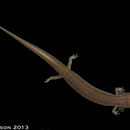Description
provided by AmphibiaWeb articles
Urspelerpes brucei is a miniaturized species, with adults reaching a standard length of only 25-26 millimeters. There is no apparent sexual dimorphism in size. This species has slender jaws with few teeth; males have spiny premaxillary teeth that are longer than those of females. Small paravomerine tooth patches are present as well as vomerine teeth. Digits are shortened but have the standard plethodontid formulae of 1-2-3-2 on the manus and 1-2-3-3-2 on the pes, highly unusual for a miniaturized form. Male have 15 costal grooves and females have 16. Males also have enlarged nasal cirri and a noticeable, round mental gland.This species resembles some salamanders of the genus Eurycea, but adult Urspelerpes brucei are much smaller than all but the smallest dwarf salamanders Eurycea quadridigitata and Eurycea chamberlaini Unlike these other miniaturized species, Urspelerpes brucei has five toes (vs. four in E. quadridigitata and E. chamberlaini) and SL is about equal to tail length (vs. much greater tail length relative to SL in the two dwarf Eurycea species). Coloration and pattern are sexually dimorphic, unlike any other known North American plethodontid. Adult males have a bright yellow dorsum with two darker pigmented dorsolateral stripes. Adult females have a more muted brownish yellow coloration due to a suffusion of numerous dark melanophores, and the dorsolateral stripes are absent. Adults have a distinctive saffron yellow patch on the snout; in larvae this patch is white. A thin dorsal stripe stretches down the center of the tail; this stripe is yellow in adults and white in larvae. The venter is yellow, without markings.Larvae are covered with small brownish melanophores except for the white snout patch; the white tail stripe has some intrusion from melanophores. No black spots or stripes are present. The venter is an unmarked white. Larval gills are relatively short and have teardrop-shaped secondary fimbriae. The tail fin is low and originates well past the vent.This species is the first new genus of amphibian to be described from the United States in almost 50 years (the previous description of a new genus was made in 1961 by Highton).The generic name is derived from the basal relationship this species has to the genus Eurycea. Ur- comes from from the Greek word for "original" and Spelerpes is a synonym for Eurycea. The specific epithet brucei honors Dr. Richard C. Bruce, Professor Emeritus of Western Carolina University and retired director of Highlands Biological Station in North Carolina.
Camp, C.D., Peterman, W.E., Milanovich, J.R., Lamb, T., Maerz, J.C., and Wake, D.B. (2009). ''A new genus and species of lungless salamander (family Plethodontidae) from the Appalachian highlands of the south-eastern United States.'' Journal of Zoology, 279, 86-94.
Distribution and Habitat
provided by AmphibiaWeb articles
The type locality is at the foot of the Blue Ridge Mountains in Stephens County, Georgia, USA. Specimens were found near a small first-order stream at the foot of the escarpment under rocks or loose-leaf litter.
Life History, Abundance, Activity, and Special Behaviors
provided by AmphibiaWeb articles
All eight specimens were associated with a small first-order stream, and were found either under rocks or in loose leaf litter along the banks of the streambed. A drought was ongoing at the time of collection and this species may be more widely distributed terrestrially when conditions are not as dry. This species is likely to be primarily secretive and fossorial. Three of the eight specimens collected were gravid females. Two had 14 eggs and the third had six eggs, all of which were visible through the translucent venters. Egg size was estimated to be between 1.5-2.0 millimeters in diameter within the female. Larval size varied widely but adult size did not, leading to the conclusion that a majority of growth must take place during the larval stage. Sexual maturity is thus likely to occur close to the time of metamorphosis, as is the case for some populations of Gyrinophilus porphyriticus. Urspelerpes brucei is thought to consume smaller terrestrial organisms by use of a projectile tongue based on observations of the tooth size and number, hyobranchial structure and jaw structure. This species is relatively scarce.
Life History, Abundance, Activity, and Special Behaviors
provided by AmphibiaWeb articles
Appears to be rare and warrants attention to conservation. Larvae were easily collected in the study stream (five in 45 minutes) but were not found in nearby streams, suggesting this species is quite restricted in its range.

